On the trams
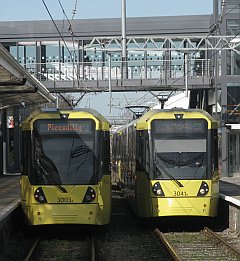
Metrolink has also seen some operational changes this spring. At Altrincham, the direct service to Bury now serves platform 2, which previously has only seen occasional use, whilst services towards Piccadilly station continue to use Platform 1.
A little confusing for passengers, perhaps, but it does give flexibility of operation, as one service can depart the moment the other has arrived.
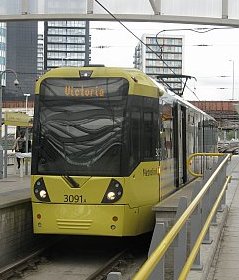
At Manchester Victoria, the two-sided middle platform has been brought into use as planned, with the Manchester Airport service extended from its temporary terminal at Deansgate-Castlefield to terminate at Victoria.
Perhaps surprisingly, trams uses the original cross-city route via Market Street. The 'second city crossing' via Exchange Square remains the preserve of the East Didsbury to Shaw and Rochdale services.
The line from Deansgate - Castlefield to St Peters Square now has as many as 35 trams per hour in each direction.
Local Rail News Pictures - Spring 2018
Images by Peter Cross and Charlie Hulme

Network Rail measurement trains bring some exotic traction to our area at times. Class 73 electro-diesels have been seen on some workings, and on 3 April, a Derby - Crewe working saw two of the four Class 97/3 (ex Class 37) locos based in Coleham, Shrewsbury for working trains on the Cambrian lines which have ERTMS signalling. Above, 97 303 (37 178) brings its train down the Hazel Grove Chord, as seen from the upper level of the station car park...
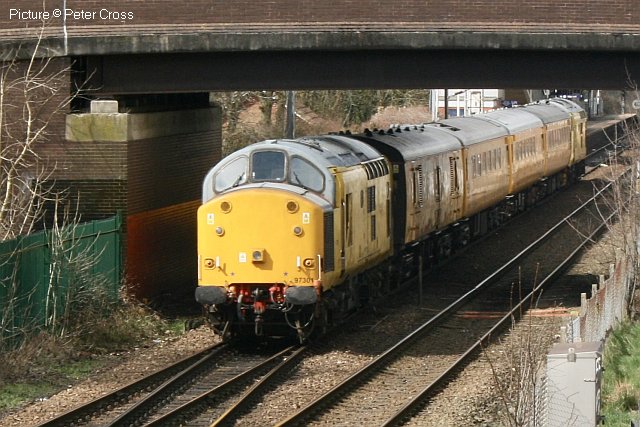
... with 97 301 (37 100) on the rear, easily recognised as the only one of the four with the early version of the Class 37 nose which had connecting doors. Pictures by Peter Cross.
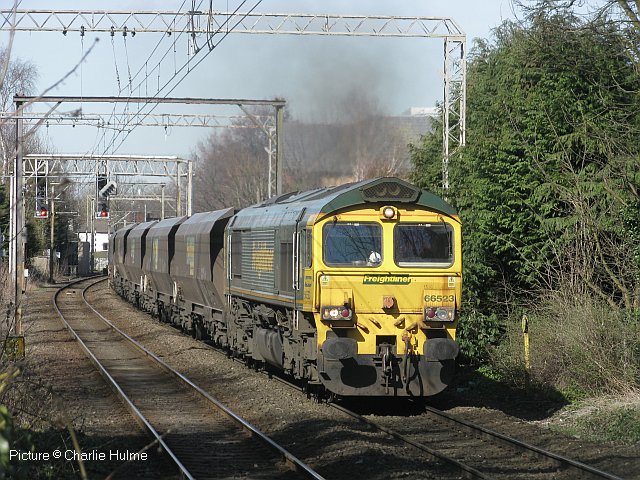
The power station at Fiddler's Ferry near Warrington, built in 1971-73 for the Central Electricity Generating Board, is still burning coal, although it is apparently able to also burn 'biomass' blended with the coal. It had several owners before sale in 2004 to current owners by Scottish and Southern Energy, along with 'Ferrybridge C' power station in Yorkshire, for £136 million. Ferrybridge was shut down in 2016, and its remaining coal stock moved by rail to Fiddlers Ferry. At present it has contracts running to September 2019.
In 2018 all its coal is imported, carried by rail from Redcar Bulk Terminal on Teesside. Trains run via York, Wakefield Kirkgate and the Calder Valley line, then Ashton Moss North Junction, Stockport (15:06) and Altrincham, returning overnight. Navigation Road Metrolink platform makes a good vantage point for this train, seen above on 5 April with 66 523.
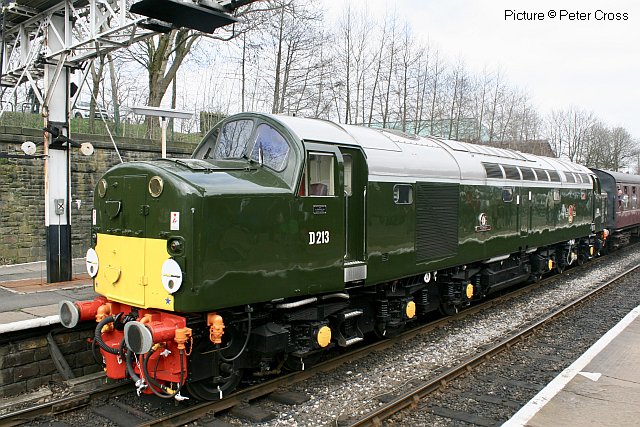
Class 40 D213 looking very smart, having had new numbers applied and a good clean, at the East Lancashire Railway event on 14 April which celebrated 60 years of the Class 40 diesels. Five were in traffic: 40 012 (D213), 40 013, 40 106, 40 135 and 40 145, with the National Railway Museum's D200 on static display (Peter Cross).
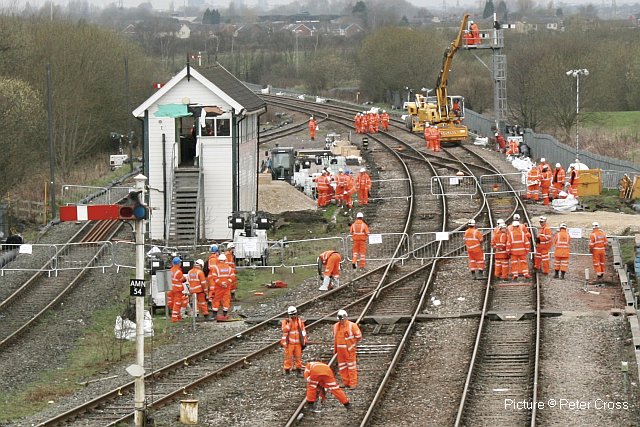
The lines through Ashton Moss North Junction were closed for 16 days in April while the junction was re-configured and the signalling modernised, involving the removal of the signalbox, a much-altered Lancashire and Yorkshire structure. Peter Cross captured the scene on 14 April.
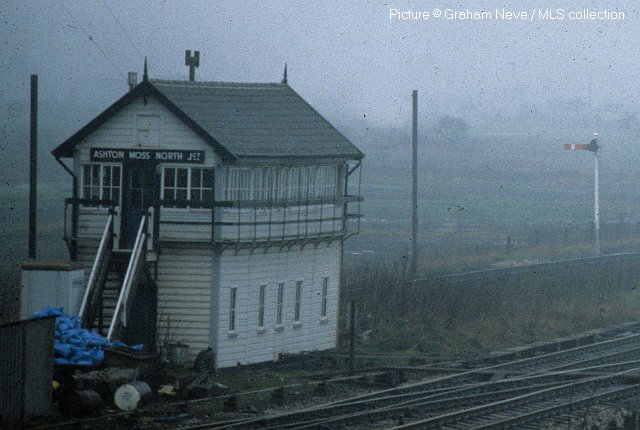
A picture from a misty day around 1980, by Graham Neve (MLS collection) showing the box before the removal of the walkway, fitting of replacement windows and PVC cladding. It was built in 1911, with 56 levers, and controlled the connecting line from the Manchester Victoria - Stalybridge route towards Denton Junction. Control has been transferred to the new Rail Operating Centre at Ashburys.
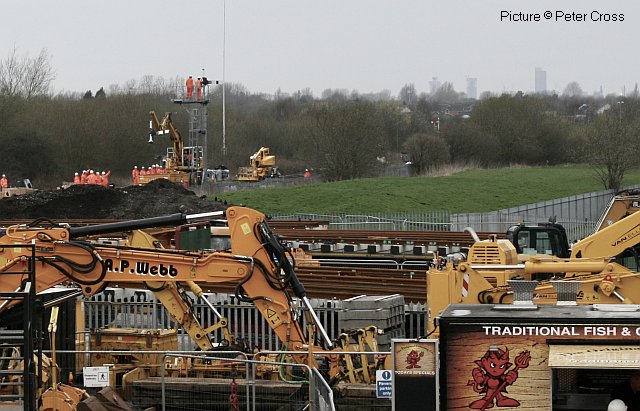
A signal arm arm on its 'dolly' being lowered from the junction home signal; the 'orange army' were provided with traditional refreshments (Peter Cross). There is an time-lapse video of the project on the Network Rail website.
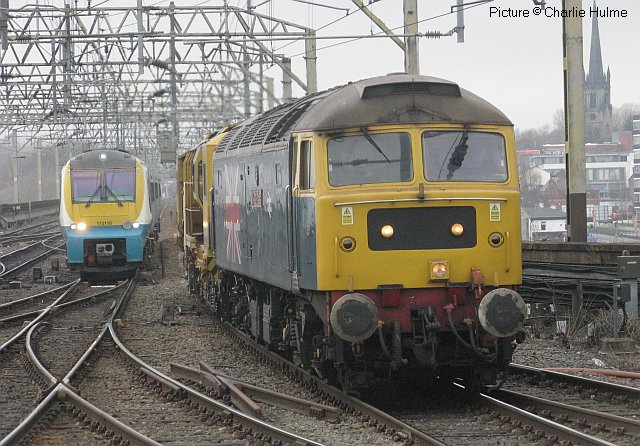
An unusual train noted at Stockport on 11 April featured 47 580 County of Essex hauling a track machine as the 11:06 Guide Bridge sidings to Dollands Moor yard, the interchange sidings for the Channel Tunnel. The train via Crewe and Northampton, and after a planned 55 minute wait at Willesden arrived at Dollands Moor at 20:25.
47 580, although operated on the main line by West Coast Railways, is owned by the Stratford Diesel Group, and has the Union Jack adornment which was first applied to two Class 47s (47 163 and 47 164) by the staff of the former Stratford Diesel Depot at the time of the 1977 Royal Silver Jubilee. Approaching on the fast line 175 110 on the 11:30 Manchester - Carmarthen.
The machine, DR77908, is a ballast regulator built by Plasser and Theurer of Austria, but it was apparently not headed for the continent, as it returned on 17 April hauled by West Coast Railways loco 47 804.
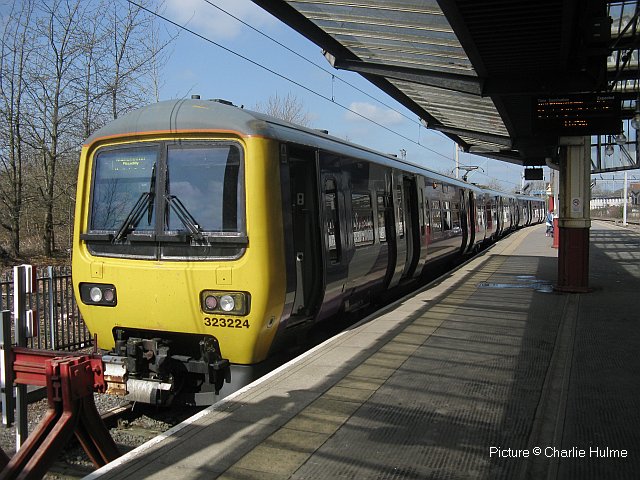
A familiar sight on the lines south of Manchester since the early 1990s have been the Hunslet-built Class 323 EMUs. 43 of these units were built, of which 17 were allocated to Manchester Longsight depot, the remainder working in the West Midlands; the situation remains the same today. The Manchester units worked the Hazel Grove, Crewe, Macclesfield and Glossop lines, replacing 1960-built stock. The 2000s saw them removed from Hazel Grove services (except for one daily train) in favour of an extension of the Macclesfield service to Stoke-on-Trent, where 323 224 is seen in bay platform 3 on 14 April. This unit, along with 223 and 225, has extra luggage space, as it was originally intended that they would work a Piccadilly - Manchester Airport Shuttle.
The new West Midlands franchisee intends to replace the 323s with new trains, while the future of the Manchester ones appears to be uncertain. Second-hand Class 319 units from the south-east are being transferred to Northern, but these have four carriages, making them too long for the Stoke bay platform; it is likely that this service will be 323 operated until the arrival of the new Class 331 sets which are 3-car. 323s are also returning to all-day working on the Hazel Grove service from 20 May, with 319s taking on most of the Crewe line diagrams.

Also noted at Stoke on 14 May,new franchise-holder West Midlands Trains are applying the brand 'London Northwestern Railway' to their long-distance services: this Class 350 was on a London - Crewe service. This operation has no connection with the LNWR train maintenance company once owned by Peter Waterman, and since sold to Arriva to become Arriva Train Care, or indeed the pre-1923 LNWR company except that the trains run on their routes.
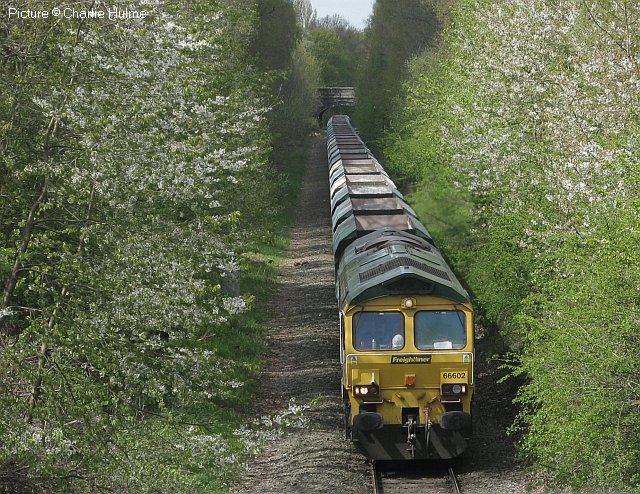
A recent change to freight working is that Freightliner have taken over from DB Cargo the Tunstead - Lostock Works workings, a much-reduced event since the other Northwich-area destination works closed down. This traffic was famous for many years among railway aficionados as the 'ICI Hoppers', and more recently as the local haunt of the Mirrlees-engined Class 60 diesels. The return empties are seen (above) from the New House Farm footpath bridge which links Woodsmoor to Bramhall, a single-track remnant that was once part of the route of Manchester Central - St Pancras expresses.
This bridge was re-opened to pedestrians and cyclists in 2014 as a public right-of-way after a long period of closure, but unfortunately much prickly undergrowth has taken hold either side of the path, especially in this direction, and the viewpoint on 1 May was only reached with difficulty.
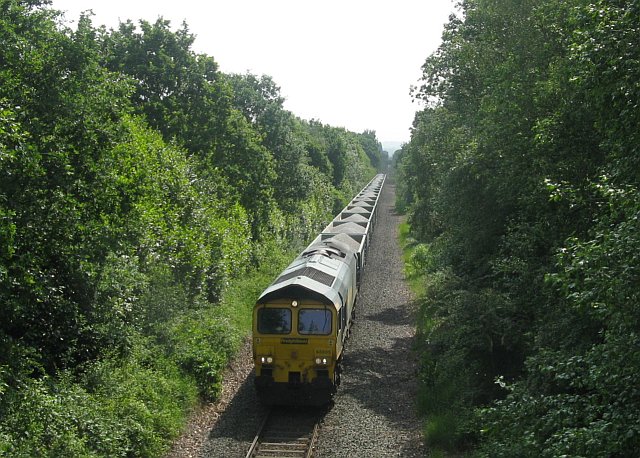
A few weeks later, on 1 June, viewed from the other side of the bridge (gaining some nettle stings in the process) looking towards Hazel Grove High Level Junction, 66 605 with a load of limestone in recently-built MWA box wagons from Tunstead quarry to a terminal at Garston, Merseyside. Each wagon can carry 77 tonnes of stone.
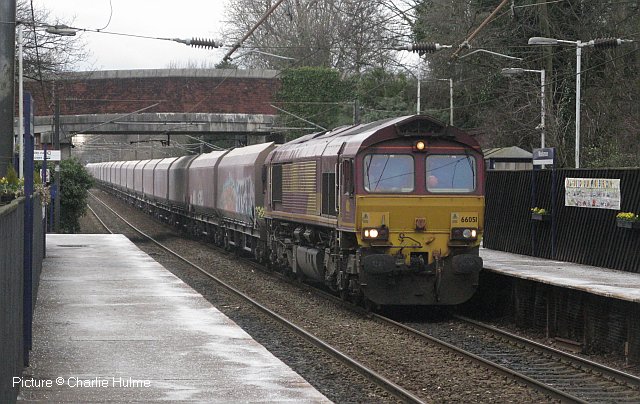
A flow which has been a regular runner for a number of years is limestone from the 'Cemex' Dove Holes Quarry to a terminal at Hope Street, Salford which runs via Chinley, Davenport and Denton Junction. Recently the timing of the loaded trains has been changed to pass Stockport at 10:02 instead of 11:15. The picture from 20 March shows the return empties, which still pass at 16:10, passing Woodsmoor with its welcome banner and daffodils organised by Woodsmoor Station Friends. The loco is DB Cargo 66 051, but as we compile this item news reaches us that GB Railfreight has taken over the service, including the former EWS coal hopper wagons, from 4 June 2018.
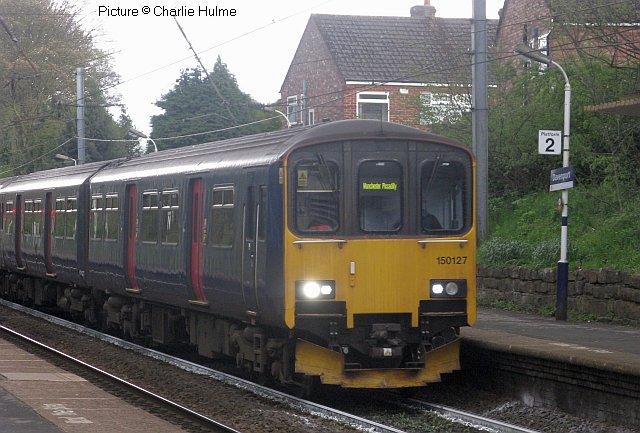
Northern Railway has been receiving additional Class 150/1 units - the first batch of 150s without end gangway connections - transferred from Great Western Railway; eventually all 50 150/1s will be with Northern. Most have entered service immediately in GWR's blue (predecessor of their current green) with pink doors, but will be sent to works in due course for refurbishment including 'passengers for reduced mobility' modifications, which must be completed by the end of 2019.
150 127, seen at Davenport on 29 April, has had a varied career. Built at Derby in 1986-87, it initially would have worked from Derby Etches Road depot. At privatisation it passed from Regional Railways (who for a time used the type on the Cambrian lines) to Central Trains, who altered the destination display to show two lines. In 2000 it was transferred to 'Silverlink' where it worked on the Barking - Gospel Oak and Bedford - Bletchley routes and gained a name, Bletchley TMD. The Barking line was transferred to London Overground in 2007 and shortly afterwards 127 found itself with Great Western.
Last update May 2018. Comments welcome: website@manlocosoc.co.uk